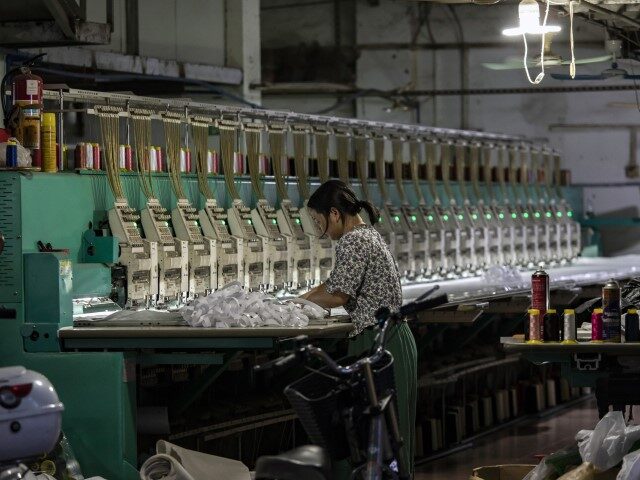The human rights organization Freedom House revealed in the latest update to its China Dissent Monitor on Wednesday that labor protests had more than doubled throughout China from the number documented in June 2022 to the same month in 2023.
Guangdong province, a factory hub in the nation’s south, documented a notable surge in acts of anti-regime dissent compared to the rest of the country.
Freedom House is a human rights research and advocacy group that documents political repression around the world. Its China Dissent Monitor, launched last year, documents incidents of dissent – protests, public expressions of opposition to the Communist Party, and other acts – in the country, revealing a constant drumbeat of anti-regime sentiment undermining the communist regime’s assurances that the Chinese people unanimously adore their totalitarian rulers.
For much of 2022, and certainly in late November of that year when protests erupted nationwide, Chinese citizens expressed outrage and disillusion with the poor handling of the Wuhan coronavirus pandemic, and in particular the use of city-wide lockdowns to place millions in a state of house arrest and the imprisonment of at least thousands in government-run quarantine camps.
“Contrary to what the CCP [Chinese Communist Party] would like the world to believe, these protests are not the only recent instance of people using public acts of dissent to speak out in China,” the president of Freedom House, Michael Abramowitz, told Breitbart News in December. “Between June and October of this year, Freedom House’s China Dissent Monitor tracked at least 822 public expressions of dissent, with incidents scattered among 27 provinces … what we’ve seen this week is likely just the tip of the iceberg.”
In its latest update, the China Dissent Monitor verified 2,803 acts of dissent throughout China between June 2022 and June 2023, attracting the participation of “at least 30,000 people.”
“The forms of dissent include demonstrations (78 percent); obstruction, occupation, and noncooperation (5 percent); contentious petitioning (4 percent); strikes (3 percent); and artistic expression (1 percent),” the report detailed.
Following the protests in late November, the Communist Party announced an end to widespread lockdowns and quarantine imprisonment, branded as an “optimization” of the brutal “zero-Covid” policy. Dissent – and government censorship – persisted, however, indicating public dissatisfaction was being fueled by factors beyond the pandemic response. Freedom House noted that factory workers were a major sector of the people organizing anti-government activity, perhaps as a result of China’s economy cratering in recent months following years of “zero-Covid” policies limiting business activity.
“The 93 labor protests collected in June 2023 are 2.35 times the number of comparable events in June 2022. This pattern may reflect the impact of China’s sluggish economy,” the report observed, adding that “much of the latest protest activity is carried out by factory workers.”
“Recent data indicates that worker dissent in Guangdong Province has seen an especially steep rise. In recent months, 35 to 50 percent of labor protest events each month have occurred in Guangdong, a proportion that is much higher than previous months,” the China Dissent Monitor continued. “As a manufacturing hub in China, Guangdong is especially impacted by contraction in this sector. Its economy also has strong links to exports and international companies as foreign investment hit an 18-year low in China.”
“These trends coincide with the Guangdong government facing a 4.8 percent drop in revenue compared to 2021,” it concluded.
Elsewhere in the report, the China Dissent Monitor observed an increase in government social media censorship in late 2022 – likely a response to the anti-lockdown protests – followed by a brief dip in censorship, and then a sudden increase in disappearances of social media messages, presumably those deemed damaging to the regime.
“Beginning in March 2023, the percentage of censored posts began to rise again, without the occurrence of a particularly sensitive event, which suggests greater generalized censorship,” the report explained. “One potential explanation is that a slow economy and its resulting social problems may be motivating authorities and social media companies to proactively raise the level of censorship.”
On Weibo, the most popular Facebook-style social media application for publishing posts, Freedom House estimated that the government was censoring about one-fifth of all posts between June 2022 and May 2023.
The Chinese economy has suffered a significant deceleration in growth, reduced import and export volume, and a catastrophic youth unemployment rate in the past year, a combination of the implementation of poor communist economic policies and the effects of the Wuhan coronavirus lockdowns. China’s economic growth declined 0.8 percent between April and June this year, preceding J.P. Morgan Chase cutting its annual growth forecast for the country. Imports fell 12.4 percent in July, while exports declined 14.5 percent.
Youth unemployment has risen so much that the Communist Party announced this month that it would simply stop publishing that statistic. In June, the National Bureau of Statistics documented a 21.3-percent unemployment rate among those aged between 16 to 24.
“Starting from this August, the release of urban unemployment rates for youth and other age groups across the country will be suspended,” bureau spokesman Fu Linghui said, allegedly to “further improve and optimise labour force survey statistics”.
The Communist Party responded to the dire economic news by publishing a speech allegedly written by genocidal dictator Xi Jinping in August, in which he asked the public for “patience.”
“We should first consider the size of the population and the large rural-urban development gap. We cannot be ambitious and unrealistic, but we cannot simply follow the beaten path. We should be patient and move forward in a steadfast manner,” the speech read in part. “It is quite a challenge just to make sure 1.4 billion people are fed. Then there are problems such as employment, [wealth] distribution, education, healthcare, housing, elderly care and childcare. They are all not easy to resolve and they all involve an astronomical number of people.”

COMMENTS
Please let us know if you're having issues with commenting.